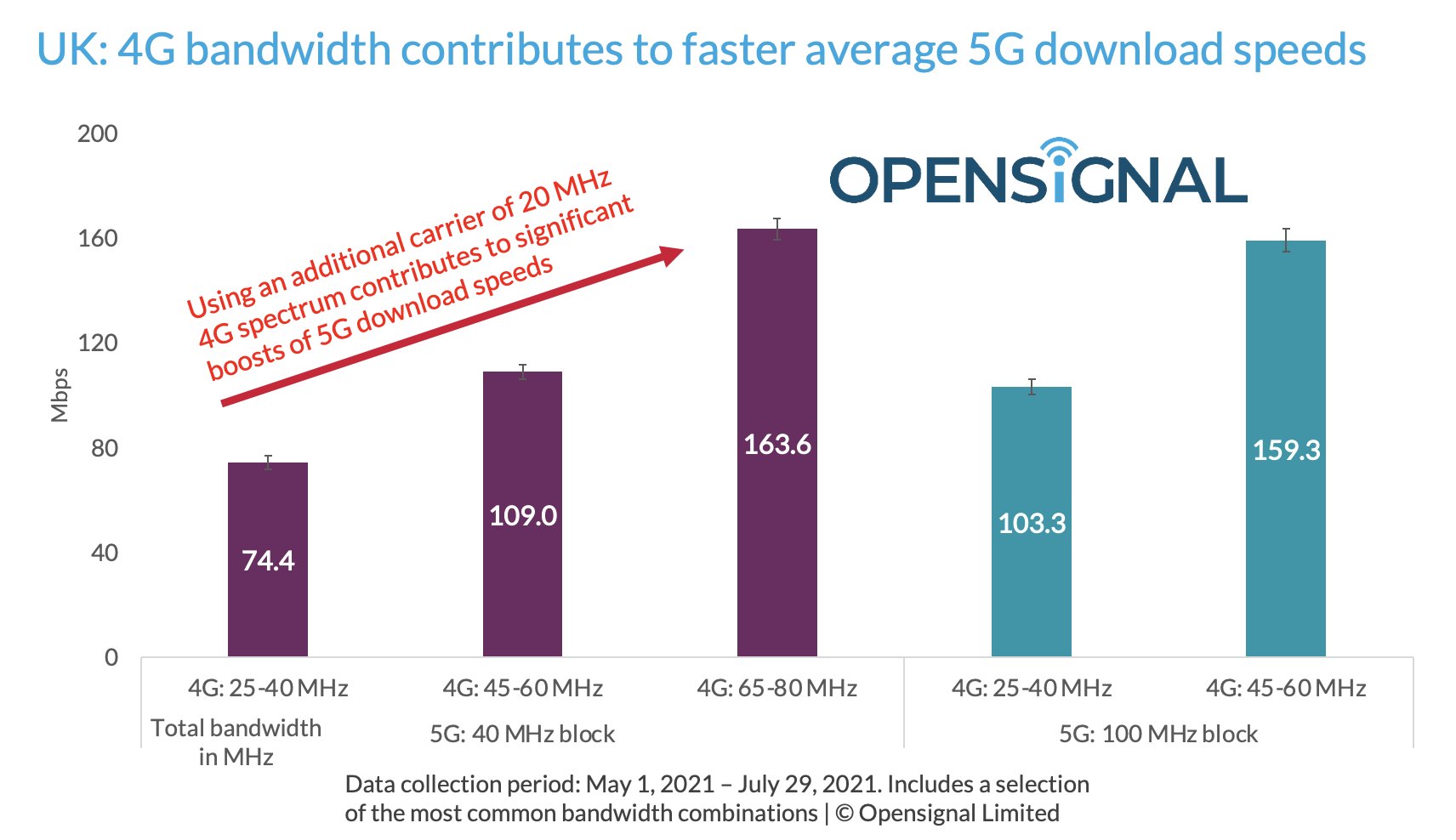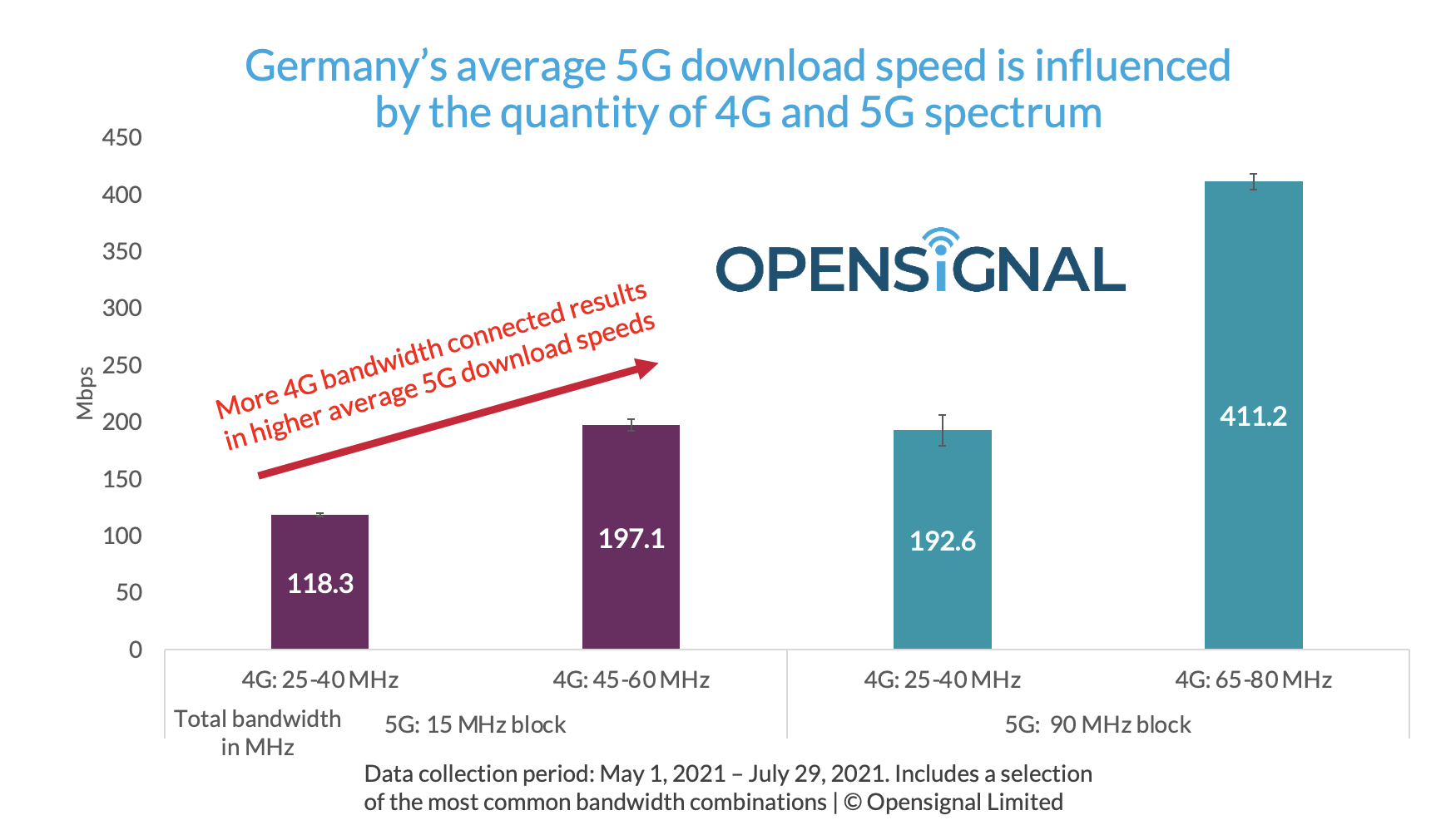Opensignal analyzed the impact of different amounts of 5G and 4G spectrum on the overall 5G mobile experience of our users. Perhaps surprisingly, our research shows that users in Germany, Italy and the UK saw significantly faster 5G average download speeds when they were also connected to additional amounts of 4G spectrum, through older 4G technology.
Early 5G networks rely heavily on 4G using non-standalone access (NSA) technology. With NSA, a smartphone must connect to at least one 4G band in order to connect to 5G. In practice, a smartphone will often connect to multiple 4G bands alongside 5G, and this 4G capacity contributes to the overall 5G speed. The availability of higher bandwidths of 4G spectrum is essential for the next generation of mobile networks. When a smartphone connects to multiple spectrum frequencies, or carriers, at once it is called Carrier Aggregation (CA).

In the UK, when we compared the same-sized continuous blocks of 40 MHz in the 3.5 and 3.7 GHz spectrum bands used for 5G supported by different bandwidths of 4G spectrum, we saw that UK operators managed to significantly boost average 5G download speeds using additional 4G spectrum capacity.
With 25-40 MHz of supporting 4G spectrum, UK operators achieved average 5G download speeds of 74.4 Mbps, as seen by our users. An additional 20 MHz (45-60 MHz) — which would mean using an extra carrier, as these can go up to 20 MHz at maximum — boosted the average 5G download speeds experienced by our users by 46.5%, to 109 Mbps. Another 20 MHz (65-80 MHz) allowed our users to see a speed increase of 50.1% (compared to 45-60 MHz), up to 163.6 Mbps.
Also, we saw a significant boost in speed from using extra 4G spectrum in instances when operators used a larger continuous block of 100 MHz of 5G spectrum — higher by 54.2%, rising from 103.3 Mbps to 159.3 Mbps.

Similarly in Germany, we looked at the same-sized continuous blocks of 15 MHz in the 5G band and how users’ average 5G download speeds varied with different 4G bandwidths. Adding 20 MHz of 4G spectrum enabled a stunning 66.6% increase from 118.3 Mbps (with 25-40 MHz of 4G spectrum) to 197.1 Mbps (with 45-60 MHz).
When we examined a much larger 5G spectrum block, we observed an even greater increase with additional 4G spectrum used. At 90 MHz of 5G spectrum, adding at least 40 MHz of 4G spectrum bandwidth — which means at least two additional carriers — brought the speed users experienced up from 192.6 Mbps to 411.2 Mbps, an increase of 113.5%.

In Italy, we also noticed increases in the average 5G download speeds experienced by Opensignal users when more 4G bandwidth was used. However, these increases were not as substantial as in the case of Germany or the UK.
With a continuous block of 20 MHz of 5G spectrum in the 3.7 GHz band and an additional 5-20 MHz of 4G bandwidth used, our users in Italy saw average 5G download speeds of 46.5 Mbps. However, an extra 40 MHz of 4G bandwidth (45-60 MHz) helped to double the speeds by 108.8%, up to 97.1 Mbps.
When we looked at a continuous 5G spectrum block of 40 MHz in the 3600-3800 MHz spectrum range, we observed average 5G download speeds of 86.2 Mbps when an additional 4G bandwidth of 45-60 MHz was used. With at least two additional carriers (or 40 MHz) of 4G bandwidth, this brought users’ average 5G speeds to 107.9 Mbps — an increase of 25.2% — with the same-sized block of 40 MHz of 5G bandwidth used. However, given the confidence intervals, this growth may not be considered as statistically significant — although it still fits the general trend of 5G speeds increasing with more 4G bandwidth used.
4G networks remain important in a 5G world
Our analysis shows that with Carrier Aggregation technology smartphones’ use of 4G bands helps to improve average 5G download speeds, especially in Germany and the UK, and to a lesser extent in Italy.
Operators that wish to offer a high-quality 5G mobile experience must also ensure that their 4G network foundation is strong. Carrier Aggregation will only grow in importance with upcoming 5G deployments, facilitating the extension of 5G coverage and the increase of network capacity. Opensignal will focus on analyzing the impact of Carrier Aggregation technology on mobile user experience in some of our future insights.
Opensignal Limited retains ownership of this insight including all intellectual property rights, data, content, graphs & analysis. Reports and insights produced by Opensignal Limited may not be quoted, reproduced, distributed, published for any commercial purpose (including use in advertisements or other promotional content) without prior written consent. Journalists are encouraged to quote information included in Opensignal reports and insights provided they include clear source attribution. For more information, contact [email protected].
